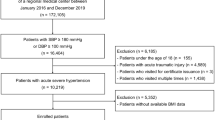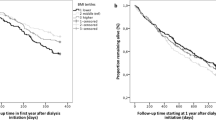Abstract
Purpose
In patients undergoing maintenance hemodialysis (MHD), increasing numbers of studies have reported a reduced mortality in patients with an increased body mass index (BMI). This article provides a meta-analysis on the assessment of the relationship between BMI and mortality in MHD patients.
Methods
A systemic literature review was conducted to identify studies that examined all-cause mortality, with or without cardiovascular events, on the basis of bodyweight or obesity measures in MHD population published before October 2012.
Results
Eight observational studies with a total of 190,163 patients were included. Compared to the individuals with a normal BMI, overweight patients and obese patients were associated with lower all-cause mortality [relative risk (RR) 0.86, 95 % confidence interval (CI) 0.84–0.88; RR 0.77, 95 % CI 0.75–0.78, respectively] and cardiovascular mortality (RR 0.86; 95 % CI 0.81–0.91; RR 0.78, 95 % CI 0.73–0.83, respectively). Underweight patients had relatively higher all-cause and cardiovascular mortality (RR 1.22, 95 % CI 1.20–1.25; RR 1.19, 95 % CI 1.11–1.28, respectively). In an obesity-stratified analysis, the patients with moderate or severe obesity presented a strongly decreased all-cause mortality risk (RR 0.64, 95 % CI 0.61–0.68) and cardiovascular mortality risk (RR 0.63, 95 % CI 0.53–0.75) compared to patients with mild obesity (RR 0.74, 95 % CI 0.71–0.77; RR 0.81, 95 % CI 0.75–0.87, respectively).
Conclusions
These findings show that overweight and obese patients have lower all-cause and cardiovascular mortality rates in patients undergoing MHD. Body weight management and optimized nutritional and metabolic support should help to reduce the high mortality rates that are prevalent in the hemodialysis population.





Similar content being viewed by others
References
Collins AJ, Foley RN, Herzog C, Chavers BM, Gilbertson D, Ishani A et al (2010) Excerpts from the US Renal Data System 2009 annual data report. Am J Kidney Dis 55(Suppl 1):S1
Sarnak MJ, Levey AS, Schoolwerth AC, Coresh J, Culleton B, Hamm LL et al (2003) Kidney disease as a risk factor for development of cardiovascular disease. Circulation 108:2154–2169
Collins AJ, Foley RN, Gilbertson DT, Chen SC (2009) The state of chronic kidney disease, ESRD, and morbidity and mortality in the first year of dialysis. J Am Soc Nephrol 4:S5–S11
Kalantar-Zadeh K, Kopple JD, Kilpatrick RD, McAllister CJ, Shinaberger CS, Gjertson DW et al (2005) Association of morbid obesity and weight change over time with cardiovascular survival in hemodialysis population. Am J Kidney Dis 46:489–500
Ritz E, Bommer J (2009) Cardiovascular problems on hemodialysis: current deficits and potential improvement. J Am Soc Nephrol 4:S71–S78
Eknoyan G, Beck GJ, Cheung AK, Daugirdas JT, Greene T, Kusek JW et al (2002) Effect of dialysis dose and membrane flux in maintenance hemodialysis. N Engl J Med 347:2010–2019
Ikizler TA, Wingard RL, Harvell J, Shyr Y, Hakim RM (1999) Association of morbidity with markers of nutrition and inflammation in chronic hemodialysis patients: a prospective study. Kidney Int 55:1945–1951
Combe C, Chauveau P, Laville M, Fouque D, Azar R, Cano N et al (2001) Influence of nutritional factors and hemodialysis adequacy on the survival of 1,610 French patients. Am J Kidney Dis 37:S81–S88
Kopple JD (2001) The National Kidney Foundation K/DOQI clinical practice guidelines for dietary protein intake for chronic dialysis patients. Am J Kidney Dis 38:S68–S73
Calle EE, Thun MJ, Petrelli JM, Rodriguez C, Heath CW Jr (1999) Body mass index and mortality in a prospective cohort of US adults. N Engl J Med 341:1097–1105
Yen TH, Lin JL, Lin-Tan DT, Hsu CW (2010) Association between body mass and mortality in maintenance hemodialysis patients. Ther Apher Dial 14:400–408
Molnar MZ, Streja E, Kovesdy CP, Bunnapradist S, Sampaio MS, Jing J et al (2011) Associations of body mass index and weight loss with mortality in transplant-waitlisted maintenance hemodialysis patients. Am J Transplant 11:725–736
Iseki K, Kawazoe N, Fukiyama K (1993) Serum albumin is a strong predictor of death in chronic dialysis patients. Kidney Int 44:115–119
Kalantar-Zadeh K, Block G, Humphreys MH, Kopple JD (2003) Reverse epidemiology of cardiovascular risk factors in maintenance dialysis patients. Kidney Int 63:793–808
Wiesholzer M, Harm F, Schuster K, Putz D, Neuhauser C, Fiedler F et al (2003) Initial body mass indexes have contrary effects on change in body weight and mortality of patients on maintenance hemodialysis treatment. J Ren Nutr 13:174–185
Stack AG, Murthy BVR, Molony DA (2004) Survival differences between peritoneal dialysis and hemodialysis among “large” ESRD patients in the United States. Kidney Int 65:2398–2408
Agarwal R (2011) Body mass index-mortality paradox in hemodialysis can it be explained by blood pressure? Hypertension 58:1014–1020
Kalantar-Zadeh K, Abbott KC, Salahudeen AK, Kilpatrick RD, Horwich TB (2005) Survival advantages of obesity in dialysis patients. Am J Clin Nutr 81:543–554
Salahudeen AK (2003) Obesity and survival on dialysis. Am J Kidney Dis 41:925–932
Fleischmann E, Teal N, Dudley J, May W, Bower JD, Salahudeen AK (1999) Influence of excess weight on mortality and hospital stay in 1,346 hemodialysis patients. Kidney Int 55:1560–1567
de Mutsert R, Snijder MB, van der Sman-de Beer F, Seidell JC, Boeschoten EW, Krediet RT et al (2007) Association between body mass index and mortality is similar in the hemodialysis population and the general population at high age and equal duration of follow-up. J Am Soc Nephrol 18:967–974
Chan M, Kelly J, Batterham M, Tapsell L (2012) Malnutrition (subjective global assessment) scores and serum albumin levels, but not body mass index values, at initiation of dialysis are independent predictors of mortality: a 10-year clinical cohort study. J Ren Nutr 22:547–557
Hoogeveen EK, Halbesma N, Rothman KJ, Stijnen T, van Dijk S, Dekker FW et al (2012) Obesity and mortality risk among younger dialysis patients. J Am Soc Nephrol 7:280–288
Jialin W, Yi Z, Weijie Y (2012) Relationship between body mass index and mortality in hemodialysis patients: a meta-analysis. Nephron Clin Pract 22:c102–c111
World Health Organization (1995) Physical status: the use and interpretation of anthropometry. Report of a WHO Expert Committee. World Health Organization technical report series. 854:1–452
Consultation WHO (2000) Obesity: preventing and managing the global epidemic. World Health Organ Tech Rep Ser 894(i–xii) 1–253
Wells G, Shea B, O’connell D, Peterson J, Welch V, Losos M et al (2000) The Newcastle-Ottawa Scale (NOS) for assessing the quality of nonrandomised studies in meta-analyses. Paper presented at the 3rd symposium on systematic reviews: beyond the basics
Normand SLT (1999) Tutorial in biostatistics meta-analysis: formulating, evaluating, combining, and reporting. Stat Med 18:321–359
Egger M, Smith GD, Schneider M, Minder C (1997) Bias in meta-analysis detected by a simple, graphical test. BMJ 315:629–634
Higgins JP, Thompson SG, Deeks JJ, Altman DG (2003) Measuring inconsistency in meta-analyses. BMJ 327:557–560
Egger M, Smith GD, Altman D (2008) Systematic reviews in health care: meta-analysis in context. BMJ books, London
Tobias A (1999) Assessing the influence of a single study in meta-analysis. Stata Tech Bull 47:15–17
Manson JE, Willett WC, Stampfer MJ, Colditz GA, Hunter DJ, Hankinson SE et al (1995) Body weight and mortality among women. N Engl J Med 333:677–685
Sturm R (2007) Increases in morbid obesity in the USA: 2000–2005. Public Health 121:492–496
Whitlock G, Lewington S, Sherliker P, Clarke R, Emberson J, Halsey J et al (2009) Body mass index and cause-specific mortality in 900,000 adults: collaborative analyses of 57 prospective studies. Lancet 373:1083–1096
Kalantar-Zadeh K, Streja E, Kovesdy CP, Oreopoulos A, Noori N, Jing J et al (2010) The obesity paradox and mortality associated with surrogates of body size and muscle mass in patients receiving hemodialysis. Mayo Clin Proc 85:991–1001
Ricks J, Molnar MZ, Kovesdy CP, Kopple JD, Norris KC, Mehrotra R et al (2011) Racial and ethnic differences in the association of body mass index and survival in maintenance hemodialysis patients. Am J Kidney Dis 58:574–582
Kalantar-Zadeh K (2005) Causes and consequences of the reverse epidemiology of body mass index in dialysis patients. J Ren Nutr 15:142
Leavey SF, McCullough K, Hecking E, Goodkin D, Port FK, Young EW (2001) Body mass index and mortality in ‘healthier’as compared with ‘sicker’haemodialysis patients: results from the Dialysis Outcomes and Practice Patterns Study (DOPPS). Nephrol Dial Transplant 16:2386–2394
Avram MM, Bonomini LV, Sreedhara R, Mittman N (1996) Predictive value of nutritional markers (albumin, creatinine, cholesterol, and hematocrit) for patients on dialysis for up to 30 years. Am J Kidney Dis 28:910–917
Leavey SF, Strawderman RL, Jones CA, Port FK, Held PJ (1998) Simple nutritional indicators as independent predictors of mortality in hemodialysis patients. Am J Kidney Dis 31:997
Sreedhara R, Avram MM, Blanco M, Batish R, Mittman N (1996) Prealbumin is the best nutritional predictor of survival in hemodialysis and peritoneal dialysis. Am J Kidney Dis 28:937
Nishizawa Y, Shoji T, Ishimura E, Inaba M, Morii H (2001) Paradox of risk factors for cardiovascular mortality in uremia: is a higher cholesterol level better for atherosclerosis in uremia? Am J Kidney Dis 38:S4–S7
Yang W, Kim S, Min W, Park S, Lee M, Park J (1995) Atherogenic lipid profile and lipoprotein (a) in relation to serum albumin in haemodialysis patients. Nephrol Dial Transplant 10:1668–1671
Ritz E (1996) Why are lipids not predictive of cardiovascular death in the dialysis patient? Miner Electrolyte Metab 22:9
Nurmohamed SA, Nubé MJ (2005) Reverse epidemiology: paradoxical observations in haemodialysis patients. Neth J Med 63:376–381
Kovesdy CP, George SM, Anderson JE, Kalantar-Zadeh K (2009) Outcome predictability of biomarkers of protein–energy wasting and inflammation in moderate and advanced chronic kidney disease. Am J Clin Nutr 90:407–414
Kalantar-Zadeh K, Kopple JD (2001) Relative contributions of nutrition and inflammation to clinical outcome in dialysis patients. Am J Kidney Dis 38:1343–1350
Kopple JD (2005) The phenomenon of altered risk factor patterns or reverse epidemiology in persons with advanced chronic kidney failure. Am J Clin Nutr 81:1257–1266
Stenvinkel P, Heimbürger O, Paultre F, Diczfalusy U, Wang T, Berglund L et al (1999) Strong association between malnutrition, inflammation, and atherosclerosis in chronic renal failure. Kidney Int 55:1899–1911
Trimarchi H, Muryan A, Dicugno M, Forrester M, Lombi F, Young P et al (2011) In hemodialysis, adiponectin, and pro-brain natriuretic peptide levels may be subjected to variations in body mass index. Hemodial Int 15:477–484
Horwich TB, Fonarow GC, Hamilton MA, MacLellan WR, Woo MA, Tillisch JH (2001) The relationship between obesity and mortality in patients with heart failure. J Am Coll Cardiol 38:789–795
Mohamed-Ali V, Goodrick S, Bulmer K, Holly JMP, Yudkin JS, Coppack SW (1999) Production of soluble tumor necrosis factor receptors by human subcutaneous adipose tissue in vivo. Am J Physiol-Endocrinol Met 277:E971–E975
Rauchhaus M, Coats AJS, Anker SD (2000) The endotoxin-lipoprotein hypothesis. Lancet 356:930–933
Kalantar-Zadeh K, Miller JE, Kovesdy CP, Mehrotra R, Lukowsky LR, Streja E et al (2010) Impact of race on hyperparathyroidism, mineral disarrays, administered vitamin D mimetic, and survival in hemodialysis patients. J Bone Miner Res 25:2724–2734
Kalantar-Zadeh K, Kovesdy CP (2009) Clinical outcomes with active versus nutritional vitamin D compounds in chronic kidney disease. J Am Soc Nephrol 4:1529–1539
Macleod J, Smith GD (2003) Psychosocial factors and public health: a suitable case for treatment? J Epidemiol Community Health 57:565–570
Sarkar S, Kuhlmann M, Kotanko P, Zhu F, Heymsfield SB, Wang J et al (2006) Metabolic consequences of body size and body composition in hemodialysis patients. Kidney Int 70:1832–1839
Stenvinkel P (2001) Malnutrition and chronic inflammation as risk factors for cardiovascular disease in chronic renal failure. Blood Purificat 19:143–151
Conflict of interest
The authors declare that they have no conflicts of interest.
Author information
Authors and Affiliations
Corresponding author
Additional information
Ting Li and Jun Liu have contributed equally to this work.
Rights and permissions
About this article
Cite this article
Li, T., Liu, J., An, S. et al. Body mass index and mortality in patients on maintenance hemodialysis: a meta-analysis. Int Urol Nephrol 46, 623–631 (2014). https://doi.org/10.1007/s11255-014-0653-x
Received:
Accepted:
Published:
Issue Date:
DOI: https://doi.org/10.1007/s11255-014-0653-x




